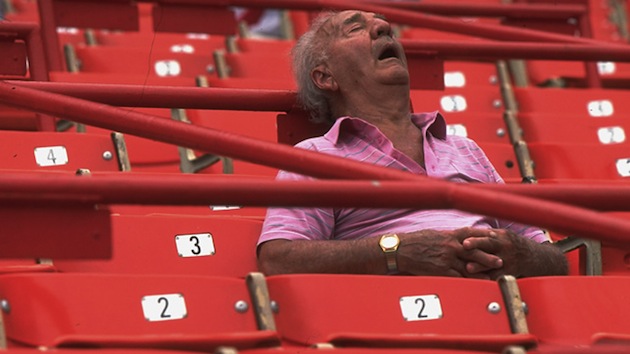Baseball was once America’s pastime. Not anymore. Today, the NFL dominates professional team sports. Baseball, despite the unbelievable quality of the game, is quickly becoming the old guys sport. Why? Because the pace of play makes it “boring”.
At least that’s what most non-baseball fans believe. We live in a time of instant gratification. People care less and less about strategy, tactics, and the intricacies of a defensive shift or a pitching match-up. And, while they may still appreciate of the beauty of a well-turned double play, they don’t want to endure a fifteen pitch, four mound visit at bat to get there. Baseball is boring because baseball is slow.
The Problem at Hand
I am not trying to be the old guy yelling “get off my lawn”, but something has to be done about the pace of play. Countless pitching changes in an inning, lefty and right specialists who face a single batter, and catchers who walk to the mound so many times you think they’re trying to meet their daily Fitbit goal have driven the average game length to over three hours.
This season’s average was almost five minutes higher than 2016 and seven more than in 2000. Of course the average Red Sox game is higher, and the average Sox-Yankees affair is much higher. It is even worse in the playoffs.
| Average Length of MLB Game 2017 | |||
| REG SEASON | BOS-NYY | BOS-HOU ALDS | WORLD SERIES |
| 3:05 | 3:27 | 3:48 | 3:42 |
Part of this is to be expected. Deeper line-ups, runners on base, and higher-pressure games slow the pace of play. Pitchers and catchers strategize each at bat like it’s the Invasion of Normandy, while managers scroll through pages of data weighing match-ups and bullpen options.
Past Proposals
Major League Baseball recognized the problem years ago and has tried in vain to address it. The two biggest measures proposed by Commissioner Rob Manfred last year were a 20-second pitch clock and a limit on mound visits. The Players Union rejected both suggestions.
The union argued that forcing pitchers to work more quickly could lead to more injuries. But, according to CBS Sports, the average time between pitches last season was 24.2 seconds. I’m not a doctor, so I can’t speak to the rehabilitative magic that an extra four seconds between pitches does for a throwing arm. But what I do know is that in a game with 300 cumulative pitches, those extra four seconds translates to 21 added minutes.
Options Moving Forward
Manfred was on the right path with his recommendations last year. There are plenty of ways to reduce the length of ball games. Here are a few:
Pitch clock.
Damn the union, the commissioner needs to exercise his “in the best interested of baseball” powers and implement the clock by fiat if necessary. If that means that, in order to prevent injuries, teams will need to lower pitch counts per start and carry more pitchers – then expand the rosters.
I do not believe that awarding a ball for each violation is a realistic punishment. That will alter the game too dramatically. Rather, I recommend that MLB impose a $100-500 fine to the team for every violation. The team can, if it chooses, pass that along to the pitcher or pay it outright.
Under this plan, a pitcher who throws 200 innings stands to lose about $40,000 a year if even just ten percent of their pitches violate the pitch clock. That’s motivation.
Eliminate the lefty-righty specialist.
What’s worse than watching Clay “Molasses” Buchholz pitch? Watching him get pulled for a lefty-specialist who faces one batter only to be pulled himself. The specialization of relief pitching may be supported by analytics, but pitching changes add tons of time to games.
The simple solution is to eliminate the one-out specialist. Not eliminate the roster spot, just require that every pitcher face not less than two batters. The only exceptions to this rule is injury or if the pitcher comes in and records the final out of the inning or game.
Limit Mound Visits.
As cute as it was to listen to Crash and Nuke discuss what to get Jimmy and Mille for their wedding, we need to cap mound visits so we can all get on with our lives.
As Matt Snyder noted, in Game 1 of the 2016 NLCS, the Dodgers had a mound visit before every single batter in the eighth inning. The Cubs had nine guys come to the plate that inning. How much time do you think that added? A lot. They scored five runs. How effective were those visits? Not very.
Under this proposal, there can be no more than one player mound visit per inning and it cannot exceed thirty seconds. Any subsequent player mound visit or any violation of time not related to injury would result in a $1,000 fine to the team.
A pitching coach or manager may visit the mound once per inning (not per pitcher) for not more than one minute. A managerial time violation would result in a $5,000 fine to the manager. Subsequent mound visits by the pitching coach or manager are allowed for pitching changes.
How Big an Impact
The total effect of these proposals would be revolutionary.
Games were 12-minutes shorter in AA and AAA ballparks with 20-second pitch clocks in 2015 than in 2014. Eliminate even one pitching change per team per game and you trim another 10-15 minutes. Keep catchers and managers from wearing out the grass to the mound with all those visits and it’s easily another eight to ten minutes per game.
I just cut the average baseball game down by 37 minutes from 3:05 to 2:28. You’re welcome.
